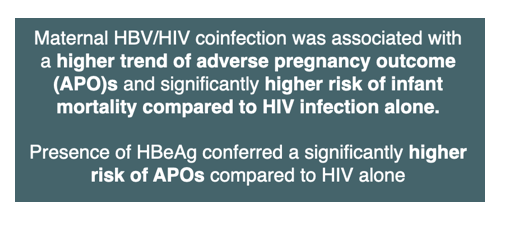| |
IMPACT OF MATERNAL HIV/HBV COINFECTION
ON PREGNANCY AND INFANT OUTCOMES
|
| |
| |
Download the PDF here
CROI 2022

Abstract Body
The impact of maternal HIV/HBV coinfection on the risk of adverse pregnancy and infant outcomes remains understudied. We compared adverse pregnancy and infant outcomes among women living with HIV/HBV versus HIV alone, randomized antepartum to three of antiretroviral (ARV) perinatal transmission regimens in the IMPAACT PROMISE study.
ARV-naïve pregnant women with HIV from Africa and India were randomized to -zidovudine (ZDV) + intrapartum nevirapine, 3TC/ZDV+LPV/r, or FTC/TDF+LPV/r. Randomizations for women with HIV/HBV mirrored the main study and follow-up of infants for this analysis was up to 2 years. Associations between HIV/HBV coinfection and pregnancy and infant outcomes were assessed by logistic (odds ratio (aOR)), linear, and cox proportional hazards a(HR) regression, adjusted for randomized arm, baseline age, log10HIV-1 RNA, CD4 count, and geographic region. HBV was defined as HBsAg positive. Adverse pregnancy outcome (APO) was a composite of low birth weight (<2500g), preterm delivery (<37 weeks), spontaneous abortion (<20 weeks), stillbirth (?20 weeks) or congenital anomaly. We further compared HBeAg positive/negative subgroups to HIV infection alone.
Between April 2011-October 2014, 3537 mother-infant pairs were analyzed, of whom 138 women had HBV/HIV coinfection. Thirty-four of 131 (26%) women were HBeAg(+). APOs were numerically higher in the HBV/HIV group vs HIV alone (33.3% vs 28.2%; aOR 1.31, 95%CI: 0.89, 1.91). HIV/HBV women who were HBeAg (+)had a significantly higher risk of APOs (aOR 2.65, 95% CI: 1.28, 5.47), vs HIV alone. Eleven (8.6% of 128) infant deaths were observed in the HIV/HBV group and 120 (3.7% of 3279) in the HIV alone groups. Infants of HIV/HBV women were at significantly higher risk for mortality (HR 2.39, 95%CI: 1.21, 4.22)(Figure). Seventy-two of 131 (55%) infant deaths occurred within 28 days. No differences were apparent between HBV/HIV and HIV alone groups in time to HIV acquisition, mean infant weight at birth and one year, WHO length- and head circumference -for-age Z-scores at one year. The above associations did not appear to differ by treatment arm.
Maternal HBV/HIV coinfection, when compared to HIV infection alone, was associated with a higher risk of APO and significantly higher infant mortality. The risk of APOs was increased in women with HBeAg. Our findings underscore the importance of early detection of HBV and HBeAg to help manage APO.
|
|
| |
| |
|
|
|